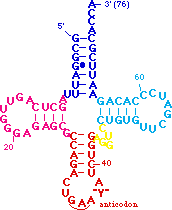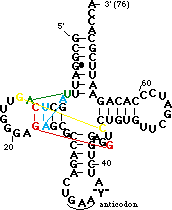Transfer RNA tour
From Proteopedia
(Difference between revisions)
| Line 15: | Line 15: | ||
[[Image:JnTerts.GIF]] | [[Image:JnTerts.GIF]] | ||
| - | <scene name='72/725890/Trna_tert_interact/2'>You can zoom in for a closer look</scene>. The yellow residues are a parallel base pair (compared to the normal anti parallel) between <B><FONT COLOR="#aaaa00">G15</FONT></B> of the <B>D-loop</B> and <B><FONT COLOR="#aaaa00">C48</FONT></B> of the <B>variable loop</B>. This brings the <B>D-loop</B> and <B>variable loop</B> together. Note the sharp turn in the backbone between <B><FONT COLOR="# | + | <scene name='72/725890/Trna_tert_interact/2'>You can zoom in for a closer look</scene>. The yellow residues are a parallel base pair (compared to the normal anti parallel) between <B><FONT COLOR="#aaaa00">G15</FONT></B> of the <B>D-loop</B> and <B><FONT COLOR="#aaaa00">C48</FONT></B> of the <B>variable loop</B>. This brings the <B>D-loop</B> and <B>variable loop</B> together. Note the sharp turn in the backbone between <B><FONT COLOR="#aaaa00">C48</FONT></B> and <B><FONT COLOR="#aaaa00">C49</FONT></B> caused by the parallel pair. |
| - | The green residues are a reverse Hoogsteen pair between <B><FONT COLOR="#00bf00">U8</FONT></B>and <B><FONT COLOR="#00bf00">A14</FONT></B>. This pairing is important for positioning of the <B>D stem</B> relative to the stacked <B>T</B> and <B>acceptor</B> stems. | + | The green residues are a reverse Hoogsteen pair between <B><FONT COLOR="#00bf00">U8</FONT></B> and <B><FONT COLOR="#00bf00">A14</FONT></B>. This pairing is important for positioning of the <B>D stem</B> relative to the stacked <B>T</B> and <B>acceptor</B> stems. |
| - | The cyan residues are a base triple in which <B><FONT COLOR="#008aff">A9</FONT></B>H-bonds in the major groove to <B><FONT COLOR="#008aff">A23</FONT></B> (which is paired with <B><FONT COLOR="#008aff">U12</FONT></B>). It stabilizes a sharp turn between bases 9 and 10. | + | The cyan residues are a base triple in which <B><FONT COLOR="#008aff">A9</FONT></B> H-bonds in the major groove to <B><FONT COLOR="#008aff">A23</FONT></B> (which is paired with <B><FONT COLOR="#008aff">U12</FONT></B>). It stabilizes a sharp turn between bases 9 and 10. |
The red residues are a base triple in which <B><FONT COLOR="#ff0000">7-methyl-G46</FONT></B> from the <B>variable loop</B> H-bonds to the <B><FONT COLOR="#ff0000">G22-C13</FONT></B> base pair of the <B>D stem</B>. This helps dock the <B>variable loop</B> onto the <B>D-stem</B>. | The red residues are a base triple in which <B><FONT COLOR="#ff0000">7-methyl-G46</FONT></B> from the <B>variable loop</B> H-bonds to the <B><FONT COLOR="#ff0000">G22-C13</FONT></B> base pair of the <B>D stem</B>. This helps dock the <B>variable loop</B> onto the <B>D-stem</B>. | ||
| Line 25: | Line 25: | ||
===U-turns=== | ===U-turns=== | ||
| - | The <scene name='72/725890/Trna_u--turn/1'>conserved ''U-turn'' motifs</scene> are responsible for turns in the <B><FONT COLOR="#ff0000">anticodon</FONT></B> and <B><FONT COLOR="#008aff">T</FONT></B> loops. The turn is stabilized by an H-bond between a conserved U residue and the phosphate backbone and an H-bond fron the O2' of the U to the N7 of a conserved purine. <scene name='72/725890/Trna_u--turn/ | + | The <scene name='72/725890/Trna_u--turn/1'>conserved ''U-turn'' motifs</scene> are responsible for turns in the <B><FONT COLOR="#ff0000">anticodon</FONT></B> and <B><FONT COLOR="#008aff">T</FONT></B> loops. The turn is stabilized by an H-bond between a conserved U residue and the phosphate backbone and an H-bond fron the O2' of the U to the N7 of a conserved purine. <scene name='72/725890/Trna_u--turn/3'>Zoom in on the anticodon-loop U-turn</scene>. Residues <B><FONT COLOR="#ff0000">33-35</FONT></B> form the <B>U-turn</B>, N3 of <B><FONT COLOR="#ff0000">U33</FONT></B> H-bonds to the phosphate oxygen of <B><FONT COLOR="#ff00ff">A36</FONT></B>, the O2' of <B><FONT COLOR="#ff0000">U33</FONT></B> H-bonds to the N7 of <B><FONT COLOR="#ff0000">A35</FONT></B>. Residues <B><FONT COLOR="#ff0000">34</FONT></B>, <B><FONT COLOR="#ff0000">35</FONT></B> and <B><FONT COLOR="#ff00ff">36</FONT></B> are the anticodon bases used in translation. The hypermodified wybutrosine <B><FONT COLOR="#aaaa00">YG37</FONT></B> is believed to form a steric block to frameshifting during translation. |
| - | The ''U-turn'' motif is repeated in the <B><FONT COLOR="#008aff">"T-loop"</FONT></B> of tRNA. Zoom in on the | + | The ''U-turn'' motif is repeated in the <B><FONT COLOR="#008aff">"T-loop"</FONT></B> of tRNA. <scene name='72/725890/Trna_u--turn/4'>Zoom in on the T-loop U-turn</scene>. Residues <B><FONT COLOR="#008aff">55-57</FONT></B> form the U-turn here. A <B>U-turn</B> is also found in the active site of the hammerhead ribozyme. |
== References == | == References == | ||
Revision as of 15:04, 27 February 2016
A-form RNA
| |||||||||||


